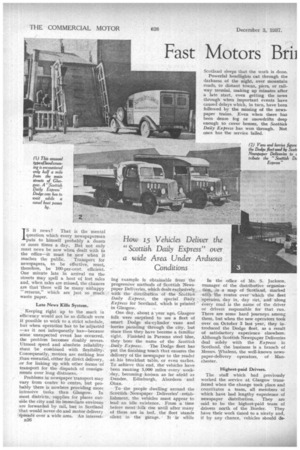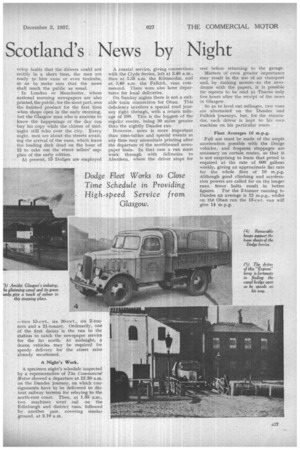Fast Motors Brii
Page 24

Page 25

If you've noticed an error in this article please click here to report it so we can fix it.
Scotland's News by Night IS it news? That is the mental question which every newspaperman puts to himself probably a dozen or more times a day.. But not only must news be new when dealt with in the office—it must be new when it
reaches the public. Transport for newspapers, to be effective, must, therefore, be 100-per-cent. efficient. One minute late in arrival on the streets may spell a host of lost sales and, when sales are missed, the chances are that 'there will be many unhappy "returns," which are just so much waste paper.
Late News Kills System.
Keeping right up to the mark in efficiency would not be so difficult were it possible to work to a strict schedule, but when operation has to be 'adjusted —as it not infrequently has—because some unexpected event has occurred, • the problem becomes doubly severe. Utmost speed and absolute reliability niust be combined with flexibility. Consequently, motors are nothing less _than essential, either for.direct delivery, or for linking tip with other forms of transport for the dispatch of consignments over long distances.
• Problems in newspaper transport-may vary from centre to centre, but probably there is nowhere providing more intensive tasks than Glasgow. In most districts, supplies for places outside the city and its immediate environs are forwarded by rail, but in Scotland that would never do and motor delivery 'spreads over a wide area. An interest 1326
g example is obtainable from' the 'progressive methods of Scottish Newspaper Deliveries, which deals exclusively. with the distribution of the 'Seatise Daily Express, the Special Daily .E.xpress for Scotland, which is printed in Glasgow.
" One day, about a year ago, Glasgow folk were surprised to see a fleet of smart Dodge six-cylinder vans and 'lorries parading through the city, but 'since then they have become a familiar sight. Finished in Parsons steel blue, they bore the name of the Scottish Daily Express. • The Dodge fleet has put the finishing touch that ensures the delivery of the newspaper to the reader at--his breakfast table, or even earlier. To achieve this end, the vehicles have been running 1,000 rnifee'every weekday, becoming .knawn as far afield as --Dundee, Edinburgh,Aberdeen and
Oban. .
Tothe people dwelling around the ,Scottish. Newspaper Deliveries' establishment, the vehicles must appear to lead an idle existence. From a time before most folk rise until after many of them are in bed, the fleet stands silent in the garage. It is' while
Scotland sleeps that the work is done.
Powerful headlights cut through the darkness of the night, over mountain roads, to distant towns, piers, or railway termini, making up minutes after a late start, even getting the news through when important events have caused delays which, in turn, have been followed by the missing of the newspaper trains. Even when there has been dense fog or snowdrifts deep enough to cover houses, the Scottish Daily Express has won through. Not once has the service failed.
In the office of Mr. S. Jackson, manager of the distributive organize tit*, a map of Scotland, marked with the routes over which the fleet operates, day in, day out,' and along every road is the name of the driver or drivers responsible for that run. There are some hard journeys among them, but when the new operators took over on October 3 last year, they introduced the Dodge fleet as a result of satisfactory experience elsewhere. Although Scottish Newspaper Deliveries deal solely with the Express in Scotland, the business is a branch of Messrs. Whalens, the well-known newspaper-delivery operators, of Manchester.
Highest-paid Drivers.
The staff which had previously worked the service at Glasgow transferred when the change took place and constitutes a team, all members of which have had lengthy experience of newspaper distribution. They are said to be the highest-paid team of drivers north of the Border. They have their work timed to a nicety and, if by any chance, vehicles should de
velop faults that the drivers could not rectify in a short time, the men are ready to hire vans or even taxicabs, so as to make sure that the news shall reach the public as usual.
In London or Manchester, where national morning newspapers are also printed, the public, for the most part, sees the finished product for the first tirne when shops open in the early morning, but the Glasgow man who is anxious to know the happenings of the day can buy his copy while the chimes of midnight still echo over the city. Every night, men are about the streets awaiting the arrival of the vans, which leave the loading deck dead on the hour of 12 to take out the street sellers' supplies of the early edition.
At present, 15 Dodges are employed
—two 13-cwt., six 30-cwt,, six 2-tonners and a 21-ton,ner. Ordinarily, one of the first duties is the run to the station to catch the newspaper service for the far north. At midnight, a dozen vehicles may be required for speedy delivery for the street sales already mentioned.
A Night's Work.
A specimen night's schedule inspected by a representative of The Cornwrcial Motor showed a departure at 12.20 a.m. on the Dundee journey, on which consignments have to be delivered to distant railway termini for relaying to the north-east coast. Then, at 1.55 a.m., two machines went ou't on the Edinburgh and district runs, followed by another pair, covering similar ground, at 2.10 a.m. A coastal service, giving connections with the Clyde ferries, left at 2.40 a.m., then at 3.35 a.m. the Kilmacolm, and at 3.40 a.m. the Falkirk, runs commenced. There were also later departures for local deliveries.
On Sunday nights there is not a suitable train connection for Oban. This deficiency involves a special road journey right through, with a return mileage of 190. This is the longest of the regular routes, being 30 miles greater than the nightly Dundee run.
. However, news is more important than time-tables and special events at any time may necessitate printing after the departure of the northbound newspaper train. In that case a van must work through with deliveries to Aberdeen, where the driver stops for
rest before returning to the garage.
Matters of even greater importance may result in the use of air transport and, by rushing motors -to the aerodrome with the papers, it is possible for reports to be read at Thurso only five hours after the receipt of the news in Glasgow.
. So as to level out mileages, two vaus are alternated on the Dundee and Falkirk journeys, but, for the remainder, each driver is kept to his own machine on his particular route.
Fleet Averages 10 m.p.g.
Full use must be made of the ample acceleration possible with the Dodge vehicles, and frequent stoppages are necessary on certain routes, so that it is not surprising to learn that petrol is required at the rate of 600 gallons weekly, giving an approximate fiat rate for the whole fleet of 10 m.p.g. Although good climbing and acceleration powers are called for on thg longer runs, fewer halts result in better figures. For the 2-tonner running to Dundee an average is 12 m.p.g., whilst on tM Oban run the 15-cwt, van will give 14 m.p.g.


































